LU celebrates grand opening of Center for Innovation, Commercialization and Entrepreneurship
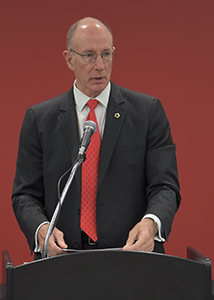 Lamar University celebrated the opening of its state-of-the-art home for the Center for Innovation, Commercialization and Entrepreneurship (CICE) today before a crowd of state, business, community, and educational leaders, in the new 21,000 square-foot innovation center.
Lamar University celebrated the opening of its state-of-the-art home for the Center for Innovation, Commercialization and Entrepreneurship (CICE) today before a crowd of state, business, community, and educational leaders, in the new 21,000 square-foot innovation center.
The new building houses 18 offices and conference rooms, four laboratories, three training rooms, an event center, a modeling and simulation center, a Student Idea Center and Hatchery, as well as the Small Business Development Center, Center for Advances in Port Management, Center for Research in Educational Innovation and Digital Learning, and High Performance Computing Laboratory.
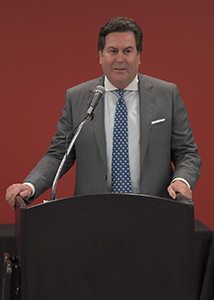 Designed by Long Architects of Beaumont and constructed by BE&K Building Group, the building is on the corner of Rolfe Christopher Drive and Jim Gilligan Way on the south end of the campus becoming part of what LU officials are calling a new gateway to the university. The building’s design complements that of the Wayne A. Reaud Administration Building that opened last fall.
Designed by Long Architects of Beaumont and constructed by BE&K Building Group, the building is on the corner of Rolfe Christopher Drive and Jim Gilligan Way on the south end of the campus becoming part of what LU officials are calling a new gateway to the university. The building’s design complements that of the Wayne A. Reaud Administration Building that opened last fall.
The CICE is a partnership between Lamar University’s College of Business and College of Engineering and the Southeast Texas business community. The center is a conduit for industry and university interaction, including projects, on-going research, student experiential learning, special events and training. The center promotes a strong emphasis on student development and training to prepare graduates for rewarding careers by familiarizing them with entrepreneurial real-world projects. New businesses supported by the center are technology-focused providing products and services for existing and future industry.
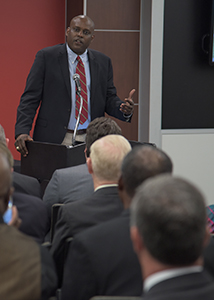 A reception and tours of the new facility followed the official opening. CICE Steering Committee members met with campus leaders following the event.
A reception and tours of the new facility followed the official opening. CICE Steering Committee members met with campus leaders following the event.
“This building when it began really changed the way we think on campus,” said President Ken Evans. “So much that we have done on campus with research and development and the funding of research is now focused on cross-disciplinary initiatives.”
“We are breaking free of the silo mentality that has so been a part of what the campus environment has been about,” Evans said. “Why do we do that? Because the problems we face today are messy. They are going to require all the talent in this room and more to fix. Pursing it from one orientation simply is not going to be enough.”
“The contributions we’ll make to Southeast Texas will be great because we’re able to deal with messy problems with the amazing people that we will assemble in this building,” Evans said.
“What you can’t see in this building are the partnerships, the new ideas, the innovations that will save and improve lives,” said Brian McCall, chancellor of the Texas State University System. “Coming from this building will be economic development, the creation of jobs, new opportunities for Lamar University to flex its research muscle. We can’t see what will come from this place, but we know it is coming.”
The CICE is “just a short distance from the site of the Lucas Gusher which, once it was tapped, transformed Texas. We look at this building as the new gusher which also will be transformative,” McCall said.
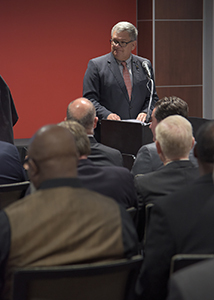 “The Greater Beaumont Chamber of Commerce and the Beaumont Economic Development Foundation find tremendous value in the CICE as one of the many assets that we promote for economic development purposes,” said Regina Lindsey, president of the Greater Beaumont Chamber of Commerce.
“The Greater Beaumont Chamber of Commerce and the Beaumont Economic Development Foundation find tremendous value in the CICE as one of the many assets that we promote for economic development purposes,” said Regina Lindsey, president of the Greater Beaumont Chamber of Commerce.
“This building will serve the region and the university through economic expansion industry advancement and workforce development,” said Paul Latiolais, director of the CICE. “The main areas of the center reflect the mission of Lamar University – economic development, industry collaboration, faculty and student innovation and community relations.”
“The CICE is also a showcase to industry were innovations and technologies can be shared between industry and Lamar University in an agile environment that encourages peer-to-peer and industry collaboration,” Latiolais said. “Industry experts from around the region can interact with business innovators and faculty to develop projects programs and products that address real needs.”
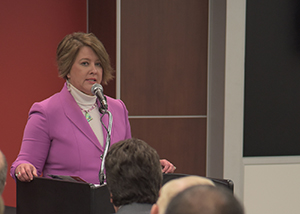 In answer to the needs of industry, the CICE has created a learning environment for workforce development, outreach and training, Latiolais said.
In answer to the needs of industry, the CICE has created a learning environment for workforce development, outreach and training, Latiolais said.
By working with experts, learning modules have been created to “help people obtain job skills in a variety of career paths from entry level positions to more advanced skills.” The program includes outreach assessment career counseling, training, promotion and involvement of employers, resume development and post-training assessment. “Helping people create new careers is an important and very satisfying part of what we do here at CICE,” he said.
Groundbreaking took place in September 2015 and construction began soon thereafter.
“For a long time, the region has seen a need to purposely grow the economy by strengthening ties to existing industry and encouraging new businesses that can diversify the economy,” said Henry Venta, dean of the College of Business and chairman of the CICE Steering Committee. “CICE is a partnership between the region and Lamar University to do exactly that – grow our regional economy through innovation, entrepreneurship, and industry collaboration.”
“The building has only been up a few weeks, and already we have seen activity with industry, workforce training, community outreach, and faculty and student development,” Venta said. By the time of the event, more than 1,200 individuals had participated in 40 events in the building since it began limited operations six weeks earlier. In addition, about 7,500 elementary and middle school students visited the building during presentations of the JASON Project, a regional program promoting education in so-called STEM disciplines – that is, science, technology, engineering and math.
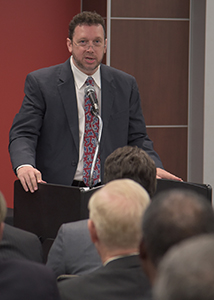 Venta recognized the work of a number of organizations that made the day possible: Facilities Management, Building and Construction at Lamar University, Long Architecture, Arceneuax Gates and Cole Engineering, contractor BE&K, Traylor and Associates and the Texas State University System office for planning and construction.
Venta recognized the work of a number of organizations that made the day possible: Facilities Management, Building and Construction at Lamar University, Long Architecture, Arceneuax Gates and Cole Engineering, contractor BE&K, Traylor and Associates and the Texas State University System office for planning and construction.
“This center represents an innovative approach to disaster recovery,” said Pete Phillips, deputy director of Community Development and Revitalization in the General Land Office. Approximately $3.2 billion in disaster recovery funds came to Texas from the Department of Housing and Urban Development as a result of Hurricane Ike. “This project is an important project for the region and the State as a whole because the innovations that will be produced here,” Phillips said.
“I also want to thank the Texas General Land Office and US Department for Housing and Urban Development for their support in embracing the idea and for providing funding,” Venta said. “I would like to express my gratitude to the Regional Planning Commission for believing in the idea and pushing it forward, and the area Chambers and Economic Development Centers for their support, as well as the Jefferson County Commissioners Court. Finally, I want to thank the CICE Steering Committee for leading this effort.”
Home to more than 15,000 students, Lamar University is among the fastest growing Texas colleges and universities, and is a member of The Texas State University System. The university has been nationally recognized for the quality of its core curriculum and the diversity of its student body. LU stresses academic achievement by emphasizing hands-on learning at all levels, providing ample opportunities for undergraduate research and supporting the outstanding Reaud Honors College. The university is accredited by the Commission on Colleges of the Southern Association of Colleges and Schools.


